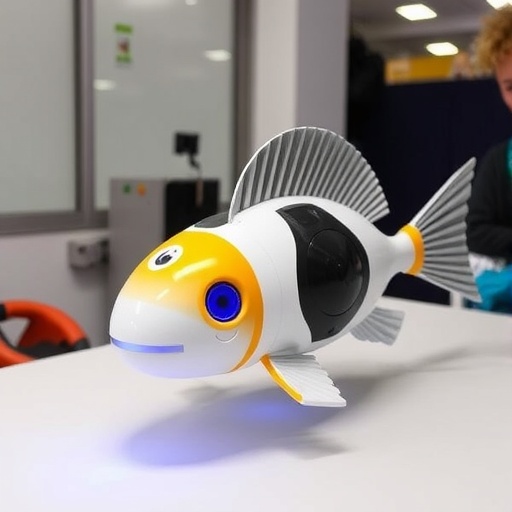At the forefront of marine technology, the Research Centre in Robotics and Underwater Technologies (CIRTESU) at Universitat Jaume I (UJI) has achieved a landmark feat with its innovative robotic fish. Recently, this sophisticated underwater robot was honored with the national award for best work in marine automation, a prestigious recognition bestowed during the Spanish Automation Committee conference held in Cartagena. The accolade acknowledges not only the groundbreaking technological integration embodied in this aquatic platform but also its tangible impact in real-world marine environments, particularly the Port of Castelló, where extensive field tests have been conducted.
This robotic fish represents a convergence of advanced mechatronics, control systems, and underwater communication technologies, resulting in an autonomous device uniquely suited to marine ecosystem inspection and maintenance. Its biomimetic design incorporates flexible fins that mimic natural fish locomotion, allowing for efficient and agile navigation under water. By deploying cutting-edge actuators that replicate fin movements, the robot achieves propulsion with minimal noise and disturbance to aquatic life, a significant advantage over traditional underwater vehicles relying on propellers.
Central to the robot fish’s functionality is its umbilical communication system, facilitating reliable data transmission between the submerged platform and surface control units. This system supports real-time wireless communication, a capability critically tested in recent trials alongside a surface robot at the experimental facilities of Port Castelló. These wireless exchanges enable synchronized operations and remote command execution, essential for intricate tasks such as inspection of sensitive environments or deployment of scientific sensors.
Equipped with an auxiliary sonar system, the robot fish navigates complex underwater terrains and performs detailed mapping of submerged structures. This sonar capability enhances situational awareness, allowing the platform to detect obstacles and features within its operational radius. Coupled with a specialized visual inspection subsystem designed explicitly for the internal examination of fish farm nets, the robot offers unprecedented insights into aquaculture infrastructure health, addressing a crucial need for sustainable aquafarming practices.
The integration of sensor deployment and retrieval mechanisms within the robot opens new frontiers for marine monitoring. By autonomously positioning environmental sensors and subsequently collecting them, the robotic system facilitates long-term data acquisition without extensive human intervention, increasing operational safety and efficiency while reducing costs. This aspect is vital in challenging aquatic environments where traditional sensor maintenance is logistically complex and hazardous.
Professor Raúl Marín, a leading researcher at CIRTESU, emphasizes the importance of incrementally rigorous testing regimes. The developmental pathway began with controlled university lab experiments and progressively extended to real-world marine settings like Port Castelló. This methodological approach ensures that each facet of the technology is validated under increasingly realistic conditions, refining system robustness and performance. Collaborative efforts with Port Authority personnel have been instrumental in this process, enabling access to diverse operational scenarios that simulate actual deployment challenges.
Environmental sustainability and animal welfare in aquaculture are central motivators behind this research. By providing a sustainable, non-invasive platform for inspection and maintenance, the robotic fish minimizes human disturbances to underwater habitats while ensuring the structural integrity of fish farming nets. These advances translate directly into improved animal safety and welfare, as timely detection of net integrity issues prevents escapes and protects farmed species from predation or disease transmission.
Looking ahead, CIRTESU’s strategic roadmap involves enhancing the robot fish’s capabilities to autonomously perform net repairs, a complex task that demands precise manipulation and sophisticated control algorithms. Developing robotic interventions to conduct maintenance operations underwater not only promises to revolutionize aquaculture logistics but also positions the technology as a scalable solution for broader marine infrastructure management.
The collaboration between Universitat Jaume I and the Port Authority of Castelló underscores a shared vision for the port as a living laboratory—a dynamic innovation hub facilitating advanced marine technology experimentation. Since formalizing their partnership in July 2024, the provision of port facilities as an isolated testbed environment has accelerated the transition of technologies from experimental prototypes towards operational readiness, elevating the Technology Readiness Level of CIRTESU’s projects.
Academic contributions underpinning this development include doctoral research led by Andrea Pino Jarque, complemented by supervision from María Rosario Vidal and Raúl Marín Prades, with overall coordination by Professor Pedro J. Sanz Valero. Additionally, the involvement of recent graduates such as Max Puig Sariñena, who contributed to underwater communication experiments, exemplifies the centre’s commitment to integrating educational initiatives with applied research.
The robot fish initiative stands as a testament to the transformative potential of interdisciplinary engineering, combining mechanics, electronics, software, and marine sciences to address real-world challenges. Its success resonates beyond national boundaries, offering a model for future autonomous underwater systems designed for environmental monitoring, infrastructure surveillance, and sustainable aquaculture.
This award-winning project not only elevates the profile of CIRTESU and Universitat Jaume I within the global robotics community but also reflects broader trends toward environmentally conscious automation. As marine industries seek innovative tools to balance productivity with ecological stewardship, technologies like the robot fish are poised to lead a new era of marine exploration and maintenance, fostering a safer and more sustainable aquatic future.
Subject of Research: Advanced biomimetic underwater robotic fish for marine environment monitoring and aquaculture maintenance.
Article Title: Award-Winning Biomimetic Robot Fish Enhances Marine Automation and Sustainable Aquaculture Monitoring at Port Castelló.
News Publication Date: September 2024
Web References: Not provided
References: Not provided
Image Credits: Universitat Jaume I of Castellón
Keywords: underwater robotics, biomimetic design, marine automation, aquaculture monitoring, sensor deployment, wireless underwater communication, sonar inspection, sustainable aquaculture, autonomous marine vehicles, robot fish, Port of Castelló, CIRTESU, Universitat Jaume I




